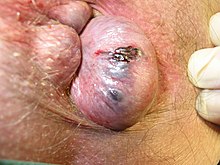Perianal hematoma

Perianal hematoma, perianal thrombosis, anal vein thrombosis, or external hemorroidal thrombosis[1] is a type of hematoma located in, or on the border of the anus.[2] It is sometimes inappropriately referred to as an external hemorrhoid.[1]
Signs and symptoms


The symptoms of a perianal hematoma can present over a short period of time. Pain, varying from mild to severe,[3] will occur as the skin surrounding the rupture expands due to pressure. This pain will usually last even after the blood has clotted, and may continue for two to four days.
Causes
Perianal hematoma are caused by the rupture of a small vein that drains blood from the anus.[4] This rupture may be the result of forceful or strained bowel movement or caused by heavy lifting, coughing or straining. Once the rupture has formed, blood quickly pools within a few hours and, if left untreated, forms a clot.
Management
If diagnosed within the first few hours of presentation, the pooling blood may be evacuated using a syringe. Once the blood has clotted, removal by this method is no longer possible and the clot can be removed via an incision over the lump under local anesthetic. The incision is not stitched, but will heal very well. Care needs to be taken in regard to bleeding from the wound and possible infection with fecal bacteria. If left alone it will usually heal within a few days or weeks.[5] The topical application of a cream containing a Heparinoid is often advised to clear the clot .[6]
References
- ^ a b Stein, Ernst (2003). Anorectal and colon diseases : textbook and color atlas of proctology (1st English ed.). Berlin: Springer-Verlag. p. 80. ISBN 9783540430391.
- ^ Australian Doctor Patient information sheet - Author: Professor John Murtagh
- ^ Anatomy by Regions - Richard S. Snell (Google Books)
- ^ MerckSource - Site Improvements In Progress
- ^ Perianal hematoma - Medbroadcast
- ^ [1]
